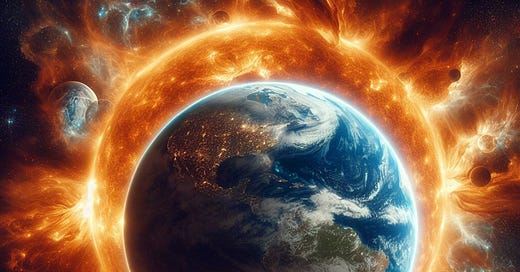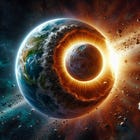Risk & Progress| A hub for essays that explore risk, human progress, and your potential. My mission is to educate, inspire, and invest in concepts that promote a better future. Subscriptions are free, paid subscribers gain access to the full archive, including the Pathways of Progress and Realize essay series.
In our search for meaning and purpose, science has lit the way, filling the cavities with knowledge and steadily pushing myth and superstition to the fringes. Over the last five centuries, scientific discovery has dramatically altered our perceived place in the universe. From the center of everything to just another planet floating in the void. These discoveries would appear to diminish our importance. I disagree, as science has displaced us from the geometric center of everything, it has elevated human civilization closer to a place of central, if metaphorical, significance.
A Human-Centered Universe
Our naked eyes can only collect enough photons of light to view a tiny sliver of the universe. From our perspective on Earth, the heavens rotate around us. We appear to lie at the center, the only conscious beings in a vast universe. A recipe for certain hubris. Historically, our conception of the heavens was rooted more in myth and philosophy than science. Aristotle thought the heavens were perfectly ordered, with the Earth at the center. The Sun and Moon were perfect spheres, orbiting Earth in perfect circles at a constant, unchanging speed. The stars were the white light of the heavens peeking through a dark mask beyond which no material substance could exist.
In this perfect universe, however, a problem vexed astronomers for millennia: the planets. Literally meaning “wanderer,” the position of the planets, unlike the stars, could not be predicted, often appearing to move forward and backward in the night sky. Aristotle’s model had a fatal flaw. Centuries after Aristotle, Ptolemy suggested that the planets had two orbits, the deferent, rotating around the Earth, and the epicycle, where it rotated within the deferent. From our perspective, this would cause a planet, at various times, to move backward and forward in the night sky. His explanation, however, could not accurately explain the planets’ movements either. For an ordered, predictable universe, this was a contradiction. Regardless, we still believed that humanity stood at the center of it all. A narcissistic ode to understandable ignorance.
Turning the Universe Upside Down
In the 1500s, Nicolaus Copernicus was among the first to challenge Aristotle and Ptolemy. He suggested that if one placed the Sun, not the Earth, at the center of the solar system, the odd movement of the planets in the sky could be explained without the need for complex orbits-within-orbits. A parsimonious proposition, but one that still could not accurately explain planetary movement. In the 1600s, Johannes Kepler accepted Copernicus's “Heliocentric” universe and further challenged Aristotle, countering that the planets didn’t orbit the Sun in perfect circles, but rather in slight ellipses. Accepting imperfection, Kepler was able to accurately predict planetary movements, but he lacked any experimental means of proving his hypothesis.
Around the same time, Galileo Galilei pointed a telescope at the night sky and finally put Aristotle’s universe to rest. Galileo saw mountains on the Moon and spots on the Sun…objective evidence that the heavens did not conform to Aristotelian perfection. More importantly, he witnessed the phases of Venus, as predicted by Copernicus, and saw moons orbiting Jupiter. Suddenly, Earth was not necessarily the center of anything. Galileo's evidence, although irrefutable, drew the wrath of the church as it went against over a millennium of Christian teachings. He spent his final years under house arrest.
It’s easy to see why; a Heliocentric solar system meant that Earth was just another planet. Why would God govern anything other than the center of the universe? Regardless, the truth could not be buried for long. A century later in the 1700s, standing upon the shoulders of Galileo and Kepler, Sir Issac Newton codified the laws of gravity and motion into mathematics. The same force that brought apples to the ground when they fell from a tree, he realized, also holds the planets around the Sun. We were no longer the center of the universe, but for the first time, humanity could understand the laws of that universe. Or so we thought.
Less Wrong
We hadn’t quite figured it out. By Newton’s time, it was known that the planets orbit in ellipses and that the orbits themselves also rotate around the Sun, in what is called precession. Newtonian physics accounted for precession and accurately predicted the movement of the planets, save for one: the planet Mercury. The explanation, it was thought, was that there was another planet near Mercury whose gravity disrupted its orbit. This theory was so prevalent that the mystery planet even had a name: Vulcan. Yet, observations with increasingly powerful telescopes in the 19th century could not locate the mysterious planet.
It turned out that Vulcan didn’t exist; it was merely another myth created to explain what we didn’t yet understand. Mercury’s orbit was not distorted by another planet, but rather by space itself. Albert Einstein’s Theory of General Relativity, published in 1915, suggested that mass warps space. For planets that are distant from the Sun, such distortions were imperceptible. For Mercury, however, the closest planet to the Sun, the impact was substantial enough to noticeably alter its orbit and render Newtonian physics alone inaccurate.
Einstein’s theory was not proven until 1919 when astronomers traveled to Brazil for a rare solar eclipse. The goal was to photograph a star cluster near the Sun at the very moment the Moon blocked its light. The images of the star cluster taken during the eclipse would be compared with images of the same cluster taken on a normal night, absent the Sun's gravitational influence. Indeed, the apparent position of the stars was slightly distorted during the eclipse, proving Einstein correct. The Sun’s mass literally bent the space around it, altering the course of light waves as they coursed toward Earth.
An Expanding Universe
Throughout all of this discovery, however, we still assumed that we were something of a rarity in the universe. Sure, the Sun was one of billions of stars, a fact proven in the 19th century. But we still believed we were living around the only star that harbored planets, residing in the only galaxy in the cosmos, the Milky Way. But not long after Einstein was vindicated, Edwin Hubble trained a telescope at Andromeda, which was thought to be a dusty galactic nebula. Using a new measurement method to measure the distance to Cepheid variable stars, he came to an astounding discovery: Andromeda was far more distant than the most distant stars in our galaxy; it was a galaxy of its own. Today, we know the Milky Way to be one of countless billions of galaxies in an ever-expanding universe. Once again, our place in the universe was diminished.
In the closing decade of the 20th Century, planets, once thought to be rare, are now discovered almost weekly. This is done by carefully observing the “wobble” of distant stars, as their planets’ gravity tugs them off center during their orbits and/or the dimming effect when a planet passes in front of them. Planets appear to be just as abundant as the many stars of the universe. We know very little about these planets, other than they provide trillions of opportunities for life to form. This fact makes it extremely unlikely that Earth is alone in the universe harboring life. Whether or not this life is intelligent and civilized is the golden question, and the implications of such a discovery are as incredible as they are frightening.
Less Special, More Important
In just 500 years, science displaced humanity from the center of the universe, the center of everything, to living on just another space rock among countless trillions. Each discovery, along the way, in some sense, made humanity less “special.” At the same time, however, these discoveries elevated the importance of our existence. As we will discuss, the apparent absence of intelligent life in this universe suggests that our consciousness, our ability to discover and understand our admittedly diminished place in this universe, could be very rare. This fact elevated our importance as agents of entropy and discovery.
You also may like…






